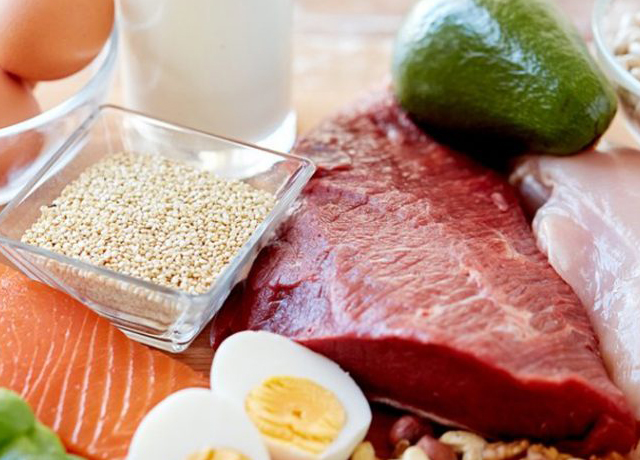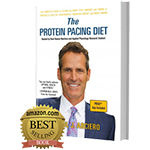I’m constantly asked what the best type of diet is for optimal health and performance and for good reason… the choices are overwhelming! There’s “low carb, high fat”, “high carb, low fat”, “high protein, low carb” “balanced carb, fat and protein”? Or whether a plant- (vegetables, legumes, grains, fruit) or animal- (meat, poultry, fish, dairy/whey) based diet is healthier. This is, by far, the most controversial diet topic out there. Even leading nutrition scientists are at odds over which diet is the best for us. And there doesn’t seem to be an easy winner emerging any time soon. However, there is one common denominator among all of these various diets that all nutrition and diet experts agree and I am the nutrition scientist who developed this nutritional strategy. It’s called ‘Protein Pacing® (www.priseprotocol.com and www.proteinpacing.com) and for the past decade, I’ve perfected the technology to maximize the benefits of Protein Pacing® with my PRISE® app (www.prisewell.com). What makes Protein Pacing® so unique and beneficial is how seamlessly it fits into any diet program. I define Protein Pacing® as the “right protein at the right time”.
Thirty years of human nutrition and metabolism research has taught me two main lessons: 1) our bodies thrive on a diet consisting of 25% to 40% lean, healthy protein (from both plant and animal sources), along with at least 25% healthy fats and oils and lots of fresh veggies, certain legumes, whole grains and fruits, and 2) performing a combination of exercise routines, as opposed to just 1 or 2 different types, on a weekly basis results in drastic health and physical performance improvements. These two scientific facts are the foundation of my Protein Pacing® diet and PRISE exercise protocol, respectively. Specific to Protein Pacing®, this diet provides significant health and performance benefits, especially if each meal contains 20-40 grams of high quality protein (Arciero et al, 2006, 2008; 2013; 2014, 2015, 2016, 2017).
Here are the specific guidelines I’ve developed for Protein Pacing® and have been using in my human nutrition and metabolism research studies for more than a decade with huge success:
- Eat 4-6 high-quality protein-based meals per day
- Evenly spaced every 3 hour
- 20-40 grams of protein at each meal
- 1st meal within 1 hour of waking in the morning
- Last meal within 2 hours of going to sleep at night
To be clear, Protein Pacing® is NOT a high protein diet. As I stated earlier, it’s the right type and amount of protein at the right time! And, don’t be fooled by all those “posers” who claim we are eating too much protein, in fact, just the opposite is true. According to well-respected and validated scientific data, as the worldwide obesity epidemic has ballooned since the 1980’s, data shows we are eating too many carbohydrates during this same time period and protein intake has decreased! Research data shows that for every 1% increase in calories from protein and 1% reduction in carbohydrate calories, overall food intake may decrease by 33 calories a day! In other words, the more healthy, lean protein consumed, the fewer calories you eat and the more likely you will lose weight and improve your health.
Thus, Protein Pacing® holds the key to healthy weight loss and optimal performance. Several human nutrition intervention studies from my laboratory at Skidmore College provide strong support for following my Protein Pacing® diet to decrease total body weight and body fat (including abdominal and harmful visceral fat), increase proportion of lean muscle mass and improve cardiovascular and metabolic health. Our study diets range between 20-40 grams per meal of high-quality animal and plant-based protein that emphasize foods such as nuts/seeds, legumes, beans, pea/brown rice protein powder, free-range eggs and poultry, grass-fed dairy products (milk, Greek yogurt, cottage cheese, whey protein powder), wild fish, and grass-fed beef.
Of course it would be amazing to eat these healthy and tasty protein foods throughout the day. But, the reality is, many of us simply do not have the time, energy, or money to prepare and purchase these foods for every meal we eat, this would be a full-time job!
Instead, I recommend we combine high quality whole foods and protein powders and bars to maximize the Protein Pacing® diet effects and I have the science to back it up! For example, sound science has proven 4 -6 meals per day containing 20-40 grams of protein per meal from both protein-rich foods and powders and bars; stimulates metabolism up to 8 times more than fat and 2.5 times more than carbs; optimizes protein synthesis needed for enhanced repair and building of lean muscle mass; and quenches hunger better than any other nutrient. All of this helps maintain an ideal body composition leading to optimal health and performance.
I’m excited to coach you to optimal health and performance using my Protein Pacing® Diet and PRISE® Protocol, both of which are the main features of my PRISE® app and Protein Pacing® Diet book.
References Cited
- Arciero PJ, Edmonds RC, Bunsawat K, Gentile CL, Ketcham C, Darin C, Renna M, Zheng Q, Zhang JZ, Ormsbee MJ. Protein-Pacing from Food or Supplementation Improves Physical Performance in Overweight Men and Women: The PRISE 2 Study. Nutrients. 2016 May 11;8(5)
- Arciero PJ, Ives SJ, Norton C, Escudero D, Minicucci O, O’Brien G, Paul M, Ormsbee MJ, Miller V, Sheridan C, He F. Protein-Pacing and Multi-Component Exercise Training Improves Physical Performance Outcomes in Exercise-Trained Women: The PRISE 3 Study. Nutrients. 2016 Jun 1;8(6)
- Arciero PJ, Edmonds R, He F, Ward E, Gumpricht E, Mohr A, Ormsbee MJ, Astrup Protein-Pacing Caloric-Restriction Enhances Body Composition Similarly in Obese Men and Women during Weight Loss and Sustains Efficacy during Long-Term Weight Maintenance. Nutrients. 2016 Jul 30;8(8).
- Arciero PJ, Gentile CL, Martin-Pressman R, Ormsbee MJ, Everett M, Zwicky L, Steele Increased dietary protein and combined high intensity aerobic and resistance exercise improves body fat distribution and cardiovascular risk factors. Int J Sport Nutr Exerc Metab. 2006 Aug;16(4):373-92.
- Arciero PJ, Gentile CL, Pressman R, Everett M, Ormsbee MJ, Martin J, Santamore J, Gorman L, Fehling PC, Vukovich MD, Nindl Moderate protein intake improves total and regional body composition and insulin sensitivity in overweight adults. Metabolism. 2008 Jun;57(6):757-65.
- Arciero PJ, Ormsbee MJ, Gentile CL, Nindl BC, Brestoff JR, Ruby Increased protein intake and meal frequency reduces abdominal fat during energy balance and energy deficit. Obesity (Silver Spring). 2013 Jul;21(7):1357-66|
- Arciero PJ, Baur D, Connelly S, Ormsbee Timed-daily ingestion of whey protein and exercise training reduces visceral adipose tissue mass and improves insulin resistance: the PRISE study. J Appl Physiol (1985). 2014 Jul 1;117(1):1-10
- Arciero PJ, Miller VJ, Ward Performance Enhancing Diets and the PRISE Protocol to Optimize Athletic Performance. J Nutr Metab. 2015;2015:715859
- Ruby M, Repka CP, Arciero Comparison of Protein-Pacing Alone or With Yoga/Stretching and Resistance Training on Glycemia, Total and Regional Body Composition, and Aerobic Fitness in Overweight Women. J Phys Act Health. 2016 Jul;13(7):754-64
- Ives SJ, Norton C, Miller V, Minicucci O, Robinson J, O’Brien G, Escudero D, Paul M, Sheridan C, Curran K, Rose K, Robinson N, He F, Arciero Multi-modal exercise training and protein-pacing enhances physical performance adaptations independent of growth hormone and BDNF but may be dependent on IGF-1 in exercise-trained men. Growth Horm IGF Res. 2017 Feb; 32:60-70.
- He F, Zuo L, Ward E, Arciero Serum Polychlorinated Biphenyls Increase and Oxidative Stress Decreases with a Protein-Pacing Caloric Restriction Diet in Obese Men and Women. Int J Environ Res Public Health. 2017 Jan 10;14(1)


